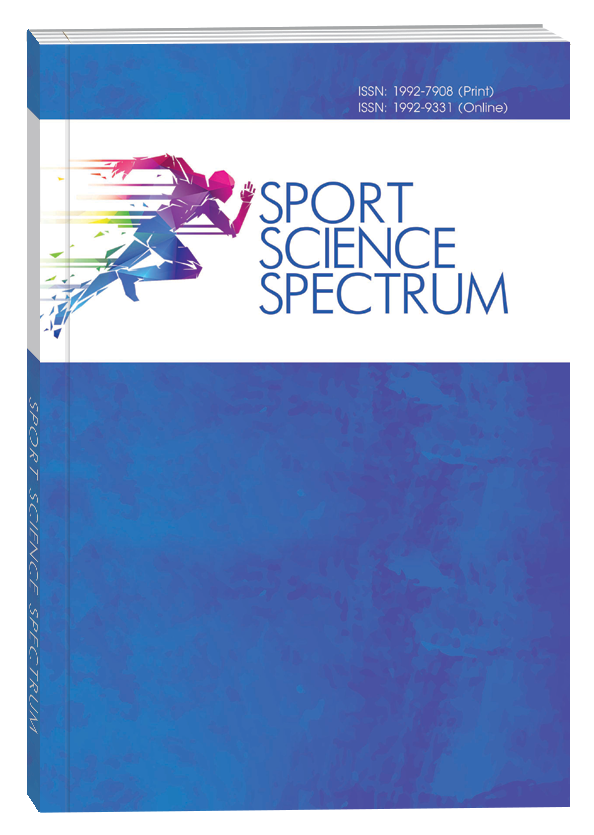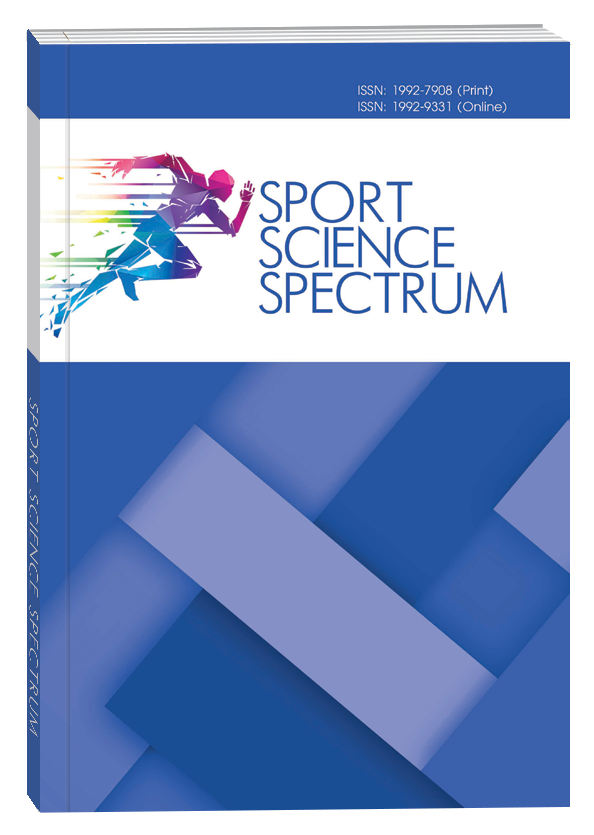FORMATION OF TEACHERS’ COMPETENCIES UNDER PHYSICAL EDUCATION TRANSFORMATION IN CHINA
DOI:
https://doi.org/10.32782/spectrum/2025-2-8Keywords:
physical education, competencies, teacher, transformation, studentsAbstract
Introduction. The transformation of physical education necessitates continuous professional development for teachers. Previous research emphasizes the importance of not only general methods of promoting physical activity but also developing specialized knowledge, particularly in working with students with special needs and utilizing modern technologies. An analysis of the current level of competencies is crucial for determining priority areas for professional development.Purpose: This study aims to assess the level of competencies of physical education teachers in key areas within the context of industry transformation.Methods: The research employed theoretical analysis and synthesis of literature, sociological research methods (survey), and statistical analysis.Results: Among the teachers surveyed, 56% reported competence in methods of promoting physical activity, but 50% expressed a desire to deepen their knowledge. Only 14% possess competencies in working with overweight students, and 6% in working with students with chronic diseases.Regarding the use of modern technologies, 20% of teachers reported competence, 18% in modern sports methodologies, and 8% in aerobic training programs; correspondingly, a significant proportion of teachers (26%, 34%, and 30%, respectively) wish to improve these competencies. Only 12% possess competencies in inclusive education, with 46% feeling a need to acquire them. Competencies in developing individual programs are present in 34% of teachers, with 36% seeking to improve them. The majority of teachers (68%) believe they have sufficient knowledge of teaching standards.The study revealed a heterogeneous level of digital competence among teachers; while 96% recognize the importance of IT, there is a significant need for the development of practical skills. Only 20% have experience in online teaching, although 30% express interest in this area. Competency development in using physical activity monitoring technologies is needed by 76% of teachers, and 60% require improved skills in applying fitness tests using technology.Conclusions. The results indicate a heterogeneous level of teacher competencies, highlighting the need for professional development in areas such as inclusive education, working with students with special needs, the use of modern technologies, and individualization of the learning process. The study revealed significant gaps in the practical application of digital technologies by physical education teachers, despite their acknowledged importance.There is an urgent need to develop and implement professional development programs covering all key aspects of digital competence, with an emphasis on practical application and methodological support. It is necessary to implement professional development programs that reflect both general trends in education development and the specific professional needs of teachers, as regulated by national standards and qualification frameworks.
References
1. Ван Сяофей. Особливості організації занять школярів з фізичного виховання в Китайській Народній Республіці. Засоби навчальної та науково-дослідної роботи. 2017. № 49. С. 208–218.
2. Ван Сяофей. Актуальні проблеми педагогічної освіти учителів фізичної культури Китайської Народної Республіки. Педагогіка та психологія. 2019. № 62. С. 48–57.
3. Вільчковський Е.С., Вільчковська А.Е., Пасічник В.Р. Фізичне виховання школярів у різних країнах світу (історія та сучасність) : монографія. Петрков-Трибунальський : NWP, 2016. 404 с.
4. Денисова Л.В., Шинкарук О.А., Лавров В.О. Зарубіжний досвід організаційно-управлінського забезпечення сфери фізичної культури і спорту в умовах цифрової трансформації. Sport Science Spectrum. 2024. № 2. С. 65–73. DOI: https://doi.org/10.32782/spectrum/2024-2-9.
5. Денисова Л.В., Шинкарук О.А. Аналіз закордонного досвіду фахової підготовки магістрів фізичної культури і спорту у закладах вищої освіти Китаю. Науковий часопис Національного педагогічного університету імені М.П. Драгоманова. Серія. 2020. № 15. 3К(123). С. 508–512.
6. Кузнецова Л., Долженко Л., Трачук С., Сяньюй Л. Аспекти функціонування системи фізичного виховання в закладах освіти Китайської Народної Республіки. Науковий Часопис Українського державного університету імені Михайла Драгоманова. 2024. № 9(182). С.153–156. DOI: https://doi.org/10.31392/UDU-nc.series15.2024.9(182).27.
7. Міжнародна хартія фізичного виховання, фізичної активності та спорту. UNESCO. 1978. URL: https://zakon.cc/law/document/read/995_350
8. Трачук С., Пальчук М., Ген Янь, Ши Янь Цзе. Складові професійної компетентності вчителів фізичної культури Китаю. Теорія і методика фізичного виховання і спорту. 2022. № 3. С. 59–63. DOI: 10.32652/tmfvs.2022.3.59–63.
9. Трачук С. В., Дєдух М. О., Бричук М. С., Воробйов М. І., Енчень Ван. Інформаційно-цифрові технології в практичній діяльності вчителів фізичного виховання Китаю. Олімпікус. 2024. № 2. С. 206–219. DOI: https://doi.org/10.24195/olympicus/2024-2.26.
10. Трачук С., Дєдух М., Бричук М., Іванік О., Єфанова В., Ван Енчень. Складові фахової кваліфікації вчителів фізичного виховання Китаю. Вісник Кам’янець-Подільського національного університету імені Івана Огієнка. Фізичне виховання, спорт і здоров’я людини. 2024. № 29(2):. С. 98–103. DOI: https://doi.org/10.32626/2309-8082.2024-29(2).98-103.
11. Цуй Лун. Особливості підготовки вчителів фізичного виховання в Китайській Народній Республіці. Адаптивне управління: теорія і практика. 2022. № 13(25). URL: https://amtp.org.ua/index.php/journal/article/view/462/402
12. Цуй Лун. Педагогічні умови розвитку професіоналізму майбутніх учителів фізичної культури в процесі фахової підготовки. Молодь і ринок. 2022. № 2(200). С. 161–165.
13. Central Committee of the Communist Party of China, State Council of China. Healthy China 2030 Blueprint Guide. 2016. URL: http://www.gov.cn/zhengce/2016-10/25/content_5124174.htm
14. Gong Yueying, Macphail Ann, Young Ann-Marie. Chinese higher education-based physical education teacher educators’ professional learning needs for involvement in research activities. Professional Development in Education. 2021. DOI: 10.1080/19415257.2021.1895286.
15. Horrell A., McMillan P., Chai G. ‘Health First’ and curriculum reform in China: The experiences of physical education teachers in one city. European Physical Education Review. 2021. № 27 (3). Р. 595–612. DOI: https://doi.org/10.1177/1356336X20977886.
16. Huang Ruixia. Research on the teaching competence of physical education teachers. Teaching and Management. 2010. Р. 41–42.
17. Lu Sanmei, Zhu Shiyan. Research on the construction of competency model for physical education teachers. Journal of Physical Education. 2012. №. 19(2). P. 83–88.
18. Meng X., Horrell A., McMillan P., Chai G. ‘Health First’ and curriculum reform in China: The experiences of physical education teachers in one city. European Physical Education Review. 2021. №27 (3). Р. 595–612. DOI: https://doi.org/10.1177/1356336X20977886.
19. The State Council. The People’s Republic of China. Outline of the “Healthy China 2030” Plan. 2016. URL: http://www.gov.cn/zhengce/2016-10/25/ content_5124174.htm
20. Thompson B. Overview of Traditional/Classical Statistical Approaches. In: Little T. D. (ed.) The Oxford Handbook of Quantitative Methods in Psychology: Statistical Analysis. Oxford Library of Psychology. 2013. Vol. 2: DOI: https://doi.org/10.1093/oxfordhb/9780199934898.013.0002.
21. Wang Lijuan, Ha Amy, Wen Xu. Teaching Perspectives of Chinese Teachers: Compatibility With the Goals of the Physical Education Curriculum. Journal of Teaching in Physical Education. 2014. № 33. Р. 13–231. DOI: 10.1123/jtpe.2013-0055.





